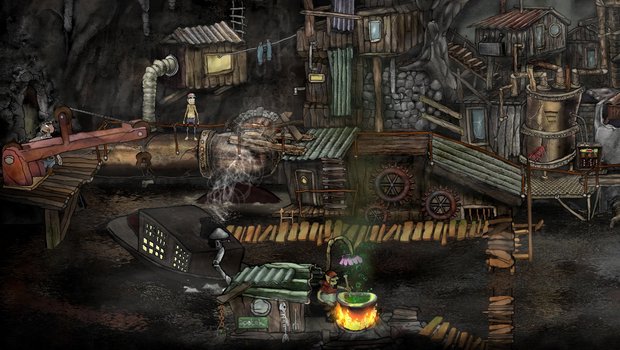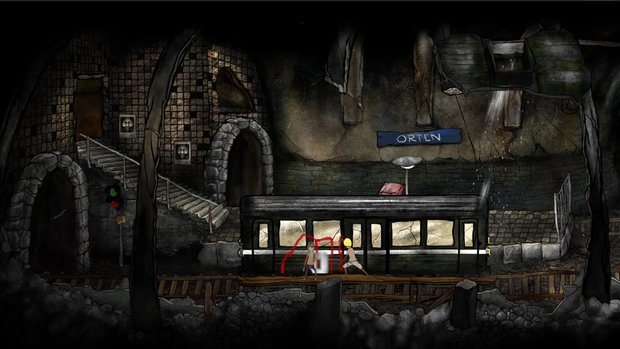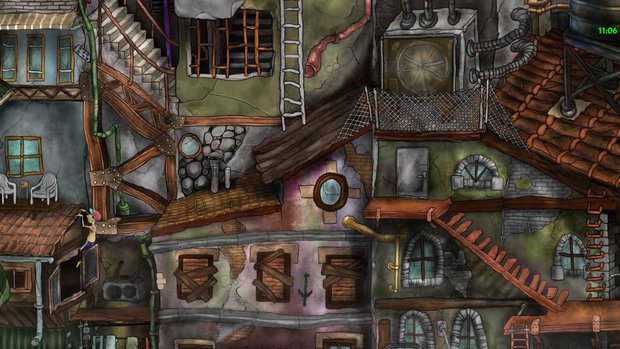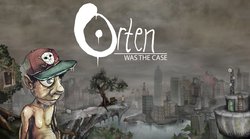Orten Was the Case review – Minutes become many intriguing hours in this hand-drawn genre-bending time looper

- 0 Comments
For the second time in three years, we have a game where you begin exactly twelve minutes before your untimely death. But while the game Twelve Minutes takes place entirely inside one apartment room, Woodhill Interactive’s Orten Was the Case spans an entire hand-drawn city from the top of its tallest building to the far depths of its underground. The seemingly random clues and disparate objectives keep the pace rather slow for a while, but it all builds into one of the more devilishly complex and rewarding time loop games to date.
You awake as Ziggy, a seemingly simple and unambitious Swedish man who resides in a trailer and lives only for the time spent with your buddies. Bizarrely, there’s a strange mark on your hand, most of your memory is gone, and your shoes are missing. After stumbling outside, a friend (whom you recognize from a picture hanging in the trailer) flags you down and convinces you to partake in a drug deal before winding down with some herb. To do so, you must escape the watchful eye of the local fuzz while making it to the dead drop in time. If successful, you will learn about where to meet one of your other buddies in the subway system. Then shortly after, you’ll hit the twelfth minute when a loud explosion and mushroom cloud destroys the entire city.
You wake up again in your trailer at the same time, only now you remember the events of the first loop, including how to find your friend near the subway. This friend recruits you to tag a train before being subsequently chased by the aforementioned cop. You’ll learn even more information about the city during this loop before being annihilated once again. Your first several loops will feel similar, exploring the haphazardly stacked apartments, the local bar, and grandma’s fishing hole, often partaking in simple fetch quests for the town’s denizens to further learn the city’s layout. However, you’ll soon discover some of the town’s hidden passageways and secrets, including the Midnight Council, an apparent terrorist group whose motives are unclear.

While the clock pauses when you access the menus, every action you take happens in real time. In other words, if you call that elevator on the 6th floor to come to the 1st floor, you just have to sit for a while until it gets there, wondering if it would have been faster to take the stairs instead. While timed games can be stressful for the average adventure gamer, the designer has gone to great lengths to make this mystery as engaging and accessible as possible, so that dying doesn’t feel like a punishment. Most importantly, you can restart the time loop any time you feel like it, which is a blessing if you’ve done all you want to do (or perhaps none of what you wanted to do) in seven minutes and don’t want to just hang out for five more waiting for the world to end. A few loops that are more intricate (or dangerous) allow for checkpoints so you don’t have to restart the whole loop if you make a mistake in your route or get killed during a combat sequence (more on this in a minute).
Taking notes is unnecessary, as you can call up a menu that not only keeps track of your objectives and details (including pictures) of clues you’ve obtained, but also keeps a twelve-minute timeline of all the things you’ve witnessed happen, including alternate timelines that can happen based on your intervention. At any time you can see exactly what every character is doing and where they should be based on your previous experiences. While initially you’ll likely be completing just one objective per time loop, the timeline is super handy (even critical on occasion) once you need to start setting several things in motion during the same loop. And if you find yourself overwhelmed with all the information, you can toggle an option to provide you with more overt on-screen clues to guide you forward.
Perhaps my favorite aspect of Orten Was the Case is that you often need to perform actions contrary to preventing the explosion, but are necessary to collect additional information for future time loops. One early example is going out of your way to temporarily save someone’s life (who will likely die anyway, explosion or no) just to get a tip from them about the Midnight Council. Saving the man takes nearly all of the twelve minutes and is not possible to do during many of your loops. Not being able to fix everything ultimately makes this Swedish town and its citizens feel alive and not just a puzzle to be solved. Another nice touch of reality is the ability to solve some puzzles (like obtaining cash for various purchases) in multiple ways, depending on the knowledge you have and your specific needs in that loop. While there are some tough adventure game-style puzzles for individual loops, such as deciphering clues to access secret hideouts or figuring out how to hide from various characters, there are no arbitrary roadblocks to your overall goal, and your only limitation is the information you don’t have.

Unfortunately, the biggest roadblock for some players will likely be the platforming and action elements. While you can use either the keyboard or a gamepad (I recommend the gamepad for the sake of speed; if you use the keyboard, you may want to remap keys as the default has you using only your left hand for everything), neither will help you consistently perform all of the precise movements that are necessary. The world is hand-drawn and cel-shaded in 2.5D space. While detailed and beautiful to look at, it makes depth difficult to gauge, making it a challenge to stay on thin ledges or perform precise jumps. It often feels like you’re slipping and sliding around the world rather than walking and running. You’ll fall frequently, and will lose hit points relative to your distance from the ground. While you do have a liberal amount of hit points, the falls are annoying, more so for the time they take away from your objective. There is an option to ensure that Ziggy always grabs a ledge so you can never accidentally fall, but several parts of the game encourage quick movements and short falls to race through objectives before the clock expires.
There are also two hand-to-hand combat events, which while not terribly demanding (even on normal difficulty), are also not terribly interesting. They’ll only serve to frustrate those who don’t like combat (and require restarting a loop or restoring to a checkpoint upon death) while adding nothing to those who do. Thankfully, neither is required more than the one time during their respective information gathering loops.
Visually, the game is a treat for the most part. Every room has its own flair. Apartments are filled with nuggets of personal information about hobbies, personal relationships, and their propensity for cleaning (or lack thereof). Plants with toxic chemicals snug right up against the residential areas. The underground, including the subway and sewers, shows glimpses into the history of the city and how it was built as well as some seriously creepy fauna. Animation is fluid, whether its Ziggy cranking open a valve, the bartender cooking a pizza, or the local garbage man emptying the dumpster. And the few cutscenes that exist (including the explosion) are effective, enhancing the story without unnecessary exposition.

Some players may be turned off by the cartoony character models, however. Ziggy himself has fish lips, bushy eyebrows, and an old man’s chest and belly (he apparently also misplaced his shirt). Other characters have buggy eyes, bulgy cheeks, ghastly skin tones, or disgusting teeth, and are not generally easy on the eyes. On the other hand, it makes the characters easy to remember and distinguish, a good thing given the sheer number of important players, none of which are voiced.
Orten Was the Case is subtitled in six languages, and while there’s no spoken dialogue, characters grunt, mumble, whisper, and squeal at appropriate times. Sound effects, such as footfall, squeaky doors, and splashing sewer water are more prevalent than the music, which is quite subdued. A scene may be punctuated by light saxophone, a piano chord, or a short strum of a stringed instrument, but for the most part the city’s natural sounds provide the atmosphere.
For those with a hearing impairment, there is an option to toggle on visual hint clues in addition to the default auditory ones. There is one section of the game that includes strobe lights that can be turned off in the main menu. Finally, there’s an “arachnophobia” setting for those who’d rather see their scary spiders with just two legs and a pair of boxing gloves.
Perhaps the most important aspect of a time loop puzzle is that the final solution be logical and sufficiently difficult to feel rewarding. While this game nicely guides you by summarizing your objectives and keeping notes, the final loop still requires significant forethought while giving you the option to tackle a few things in alternate ways if you can squeeze your ideas into twelve minutes. I certainly did not come up with the most efficient plan and successfully completed my final loop with about ten seconds remaining.
While you could theoretically finish the game on your first loop if you knew what to do, it took me around ten hours or so to reach that point and get one of three endings, the easiest to reach. The other two endings require significantly more exploration and deduction than I was willing (and likely able) to take on. These involve optional sidequests (such as setting up two of the town’s citizens on a date) that I didn’t even realize existed, let alone have any idea how to solve. I didn’t feel compelled to seek them out, given how exhausted I already was after putting together all of the puzzle pieces to solve the main mystery. But for those who want to spend more time in the world, there’s quite a bit more fun to be had. I finished the game with a 76% completion rating, so I clearly missed out on many town secrets along the way.
You may be wondering about the impetus for Ziggy being in a time loop in the first place. The game certainly could have gotten away with “just ’cause,” but the answer to this question is revealed upon completion, neither by exposition nor a cutscene, but rather with the briefest of visual cues that only makes sense if you’ve learned the city’s lore along the way. Not only does the answer hit you like a wave, it provides an emotional gut punch that comes out of nowhere. The restraint and trust in the player’s intelligence to figure it out is a rare gift that deserves a special note of appreciation.
Final Verdict
Orten Was the Case is a fine inclusion in the analog of time loop mysteries. The game mechanics are introduced slowly with several helpful menus to keep track of what you’ve learned, while the story becomes increasingly complex as you peel each layer off the onion. Players that are not adept at platforming (especially given the uneven controls) may find it difficult to get into, but those who can adapt will be rewarded with an exceptionally intricate twelve-minute puzzle that will take fifty times longer to solve.
Hot take
Time loop mysteries require a delicate balance of challenge while rewarding players for both their successes and mistakes. In Orten Was the Case, the play control and action elements can upset that balance at times, but the twelve-minute puzzle itself hits all the right beats and proves to be quite satisfying.
Pros
- Incredibly complex, well-layered time loop mystery with several satisfying smaller puzzles
- Menus provide exceptional notes and timeline tracking so you don’t have to
- Hand-drawn backgrounds are a sight to look at
- Both endings are rewarding in their own way
Cons
- Controls can be rough, leading to an unnecessary amount of falling and mistimed jumps
- Some character models are a bit off-putting
- Hand-to-hand combat, while not frequent or difficult, is out of place
Beau played Orten Was the Case on PC using a review code provided by the game's publisher.

- Advertisement
- Help support AGH by advertising with us











0 Comments
Want to join the discussion? Leave a comment as guest, sign in or register.
Leave a comment